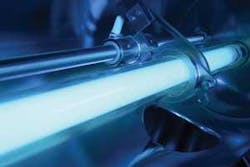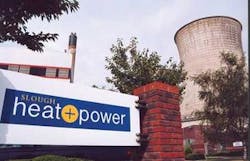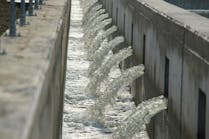by Marc C. Scanlon
Cooling towers are used to dissipate heat produced by industrial processes such as power generation, oil refining and chemical processing. They generally work in two ways, either through evaporation of water to remove heat and cool process fluid, or relying solely on air to cool the fluid.
Towers utilizing water evaporation are an ideal breeding ground for microorganisms — many of them pathogenic — which thrive in the warm, wet conditions, forming "biofilms." Various species of Legionella bacteria, the cause of Legionnaires' disease in humans, are commonly associated with cooling towers and must be controlled by law. As well as health risks for surrounding populations, biofilms also cause many mechanical problems with the cooling process, such as a reduction in heat transfer, microbial corrosion, interference with corrosion inhibitor effectiveness, and water flow disruption.
There are several ways of controlling microbial infection, including biocides such as chlorine, chlorine dioxide, hypobromite and ozone. In addition, a non-chemical method that's gaining increasing acceptance is ultraviolet (UV) disinfection. Whatever treatment method is used faces many demands and needs to meet the following criteria:
- It should be effective against all microorganisms.
- It should work fast.
- It should have a residual effect.
- It should be cost effective.
- It should be easy to use.
- It should have minimal environmental impact.
It's often recommended two treatment methods be used simultaneously to control biofilms and Legionella. UV, in combination with another biocide, meets all of the above criteria, with much reduced reliance on the secondary biocide.
UV Disinfection Advantages
UV disinfection, with secondary dosing using a suitable biocide, is in fact one of the most cost-effective and efficient methods of reducing biofilms in cooling tower water. It works instantaneously against all waterborne microorganisms, including bacteria, viruses, molds, spores and protozoa — not excluding those resistant to chlorine. UV systems also are easy to use and can be effectively monitored and integrated with online process control systems.
The only other requirement is residual disinfection. Because UV has no residual effect it cannot reduce levels of bacteria colonizing pipework walls. To achieve this, dosing with a secondary biocide is required. Even though residual disinfection is always needed, UV dramatically reduces the frequency and level of secondary dosing and therefore reduces costs and safety issues associated with purchasing, handling and transporting chemicals.
UV disinfection systems are very compact, modular and easy to install into existing water treatment systems. In addition, secondary dosing doesn't require complex monitoring equipment necessary if biocides are used as a primary disinfectant. UV also doesn't cause formation of chemical disinfection by-products, many of which can have undesired effects of their own.
How UV Works
UV is the part of the electromagnetic spectrum between visible light and X-rays. The specific portion of the UV spectrum between 185-400nm (also known as UV-C) has a strong germicidal effect, with peak effectiveness at 265nm (although some put it at 254nm). At these wavelengths, UV kills microorganisms by penetrating their cell membranes and damaging the DNA, making them unable to reproduce and effectively killing them.
A typical UV disinfection system consists of a UV lamp housed in a protective quartz sleeve which is mounted within a cylindrical stainless steel chamber. The water to be treated enters at one end and passes along the entire length of the chamber before exiting at the other end.
UV System Design
UV systems for cooling water treatment should be installed post-filtration. The UV dose received by a microorganism is dependent on the energy output of the UV lamp, water flow rate, ability of the water to transmit UV (its transmittance value), and also the geometry of the treatment chamber. Proper design of the treatment chamber must take all of these factors into account. Transmittance is especially important and is a measure of the amount of UV light absorbed or scattered by suspended material in the water. This can vary considerably depending on the source of the water and its level of purity, so a transmittance test should always be carried out to determine correct UV system design.
As flow rates increase, chamber size and lamp power output can be increased as required. For larger flows, multiple chambers are used, in series or in parallel, until the required degree of disinfection is reached. The use of high intensity, medium pressure UV lamps is recommended to treat large flow rates, as these produce a high UV output without taking up valuable space.
Reliable disinfection requires that a constant UV dose is applied to the water. Power transformers are available to absorb fluctuations in power supply while maintaining constant power to the UV lamp(s). Power switching options are also available, adjusting the lamp power on-line as the water flow or the quality of the water changes. The power switching option maintains a constant, pre-determined UV dose level whilst ensuring maximum energy efficiency.
In most disinfection systems, an instantaneous means of monitoring UV effectiveness is desirable. With chemical dosing techniques, disinfection is presumed to have been effective after a certain dose has been applied. Similarly with UV, if a minimum dose of UV energy, calculated from the maximum flow rate and taking into account water transmittance, can be shown to have reached the outer surface of the treatment chamber (where the UV monitor is situated) then the necessary disinfection has taken place. The UV monitor can detect variations in the transmittance value of the water and helps to adjust the UV output accordingly, ensuring consistent UV disinfection at all times.
Conclusion
If used in conjunction with a secondary chemical biocide, UV disinfection is one of the most cost-effective methods of controlling biofilms in cooling tower water. It's especially effective against the Legionella bacterium, a microorganism which thrives in the warm, wet, sheltered environment of a cooling tower. UV works instantly and is effective against all waterborne microorganisms, including those resistant to chlorine. Treatment systems are very compact and can usually be retrofitted easily to existing water treatment systems. In addition, secondary dosing doesn't require the complex monitoring equipment necessary if biocides are used as a primary disinfectant. All these factors add up to a simple, effective treatment process that saves the operator time and money while providing reliable protection against the spread of dangerous diseases.
About the Author: Marc C. Scanlon is national industrial sales manager for Aquionics Inc., a Halma company based in Erlanger, KY, that's a specialist in non-chemical disinfection via ultraviolet light of water, air and surfaces in a diverse range of applications. Contact: 800-925-0440 or www.aquionics.com


